Campus News
How to Talk to an Astronaut • From Pet to Threat • Wellness On the Way
How to Talk to an Astronaut
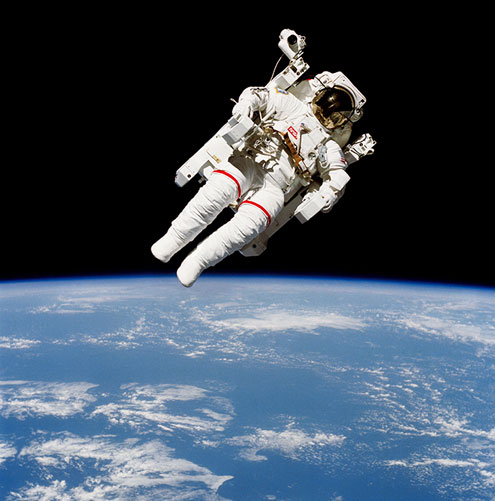
Photo by NASA
Astronauts on board the Pioneer, a spacecraft heading home from Mars, are categorizing asteroid samples when their life-support system suddenly malfunctions. The only person who can help is the NASA engineer with the information they need to get the system up and running. But in deep space, communication is delayed — each message takes five minutes to transmit, followed by another five minutes to receive a response. Their communications grow panicked, responses get confused, and the minutes between each message seem to drag on.
In reality, the astronaut and engineer are less than 10 feet apart. They are SF State students engaged in a simulation exercise, holed up in side-by-side, closet-size offices pretending to be separated by millions of miles.
Lessons learned from these students’ experiences will be used to improve communication among actual NASA astronauts on deep-space missions — such as circumnavigating Mars, where the delay is expected to stretch up to 20 minutes each way.
“We’re assessing the impact of the time delay on performance effectiveness and developing protocols and procedures that astronauts will eventually use to counteract the negative effects,” explains Professor of Psychology Kathleen Mosier, who is leading the NASA-funded research.
Mosier, an organizational psychologist who worked at the NASA Ames Research Center prior to SF State, says her students have been excited to participate. Even if they don’t actually get to travel to Mars, their research, in a sense, will.
Some of the team’s time-delay communication protocols are already being implemented in NASA simulations.
From Pet to Threat
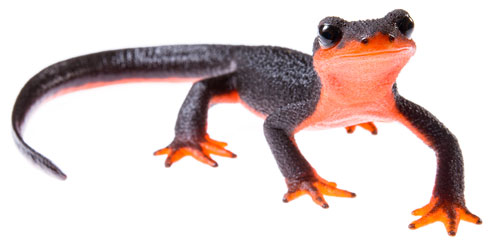
Photo by Emanuele Biggi
While they're not going to replace dogs and cats as our favorite furry (or in this case slimy) friends anytime soon, salamanders are popular as pets worldwide. Unfortunately, the high demand has led to a new ecological threat, but SF State experts are on the case.
A deadly fungus called Batrachochytrium salamandrivorans (or Bsal) likely originated in Asian species of salamander. When the fungus made its way into Europe through the pet trade, it caused a 96 percent fatality rate among the European salamander species that it infected. It was also fatal to American salamanders exposed to the fungus in the lab.
Salamanders are one of the most abundant vertebrate animals in North American ecosystems and play a number of key ecological roles. If the fungus made its way into the wild here, it could be a disaster that reaches far beyond salamanders.
“They are important predators of insects, but also an important part of the food chain,” says Associate Professor of Biology Vance Vredenburg.
Vredenburg, graduate student Tiffany Yap and colleagues at the University of California, Berkeley, and the University of California, Los Angeles, recently wrote a report calling for quick action. Vredenburg and his coauthors are asking the U.S. Fish and Wildlife Service to place an immediate ban on salamander imports until there is a plan in place to prevent the spread of Bsal.
Although the ban has been supported by other key scientists, the government has been slow to act. Yet Vredenburg remains hopeful it’s not too late — providing people keep pushing the government to do something.
“This is an imminent threat, and a place where policy could have a very positive effect,” Vredenburg says. “We actually have a decent chance of preventing a major catastrophe.”
Wellness on the Way
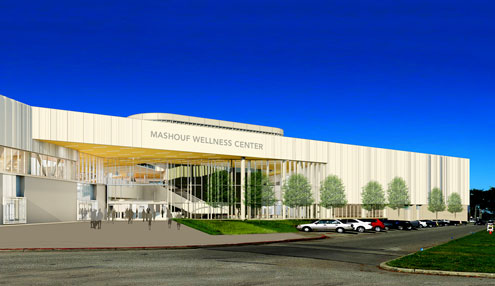
Ground has been broken on the Mashouf Wellness Center, the first major facility to be built on campus in more than a decade.
Located near student housing at the corner of Font and Lake Merced boulevards, the facility scheduled for completion in 2017 will include an indoor jogging track, fitness areas, pools, a climbing wall, racquetball courts and a large multi-use space for sports, lectures and dances.
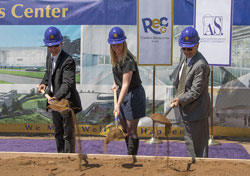
Manny Mashouf, Phoebe Dye and President Les Wong. Photo by Paul Asper.
The new hub of student life will also showcase the latest in green building technology. Pool discharge water will be captured and filtered for reuse in toilet flushing, for example, and a greywater system will repurpose shower and sink wastewater to irrigate the site. Additional environmentally friendly features will include LED lighting, drought-resistant landscaping and a displacement ventilation system to minimize the use of air conditioning.
Student fees and private donations, including a lead gift from Manny Mashouf (B.A. ’66), founder of the women’s fashion brand bebe, and his family are funding the construction.
SF State’s student government, Associated Students, Inc. (ASI), has 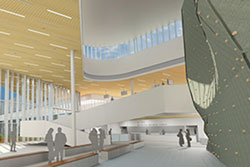 been deeply involved in plans for the center throughout every step of the process. “It’s sort of our baby,” says ASI President Phoebe Dye. “Students have worked really hard to make the center a reality.”
been deeply involved in plans for the center throughout every step of the process. “It’s sort of our baby,” says ASI President Phoebe Dye. “Students have worked really hard to make the center a reality.”
Photo renderings courtesy of WRNS Studios.
For more information: cpdc.sfsu.edu/campus-design.
Back to Fall/Winter 2015 index
Share this story:
